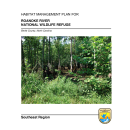What We Do
Wildlife conservation is at the heart of the National Wildlife Refuge System. It drives everything on U.S. Fish and Wildlife Service lands and waters managed within the Refuge System, from the purposes for which a national wildlife refuge national wildlife refuge
A national wildlife refuge is typically a contiguous area of land and water managed by the U.S. Fish and Wildlife Service for the conservation and, where appropriate, restoration of fish, wildlife and plant resources and their habitats for the benefit of present and future generations of Americans.
Learn more about national wildlife refuge is established to the recreational activities offered to the resource management tools used. Using conservation best practices, the Refuge System manages Service lands and waters to help ensure the survival of native wildlife species.
Management and Conservation
Refuges deploy a host of scientifically sound management tools to address biological challenges. These tools span active water management to wilderness character monitoring, all aimed at ensuring a balanced conservation approach to benefit both wildlife and people. At this field station our conservation tool box includes:
- Planning – Comprehensive Conservation Plan
- Habitat Restoration
- Conservation Easements
- Compatibility Determinations
- Invasive Species
- Inventory and Monitoring
- Land Acquisition
- Pesticide Management
- Recreation Management
- Species Research
Our Services
Staff member Sherrie Jager is the North Carolina Coordinator for the U.S. Fish and Wildlife Service Junior Duck Stamp Program. As coordinator, Sherrie provides programs detailing the program and oversees North Carolina entries in the Junior Duck Stamp Art Contest.
The Junior Duck Stamp Conservation and Design Program is a dynamic, art and science program designed to teach wetlands habitat and waterfowl conservation to students in kindergarten through high school and help reconnect youth with the outdoors. The program guides students, using scientific and wildlife observation principles, to communicate visually what they have learned through an entry into the Junior Duck Stamp art contest. This non-traditional pairing of subjects brings new interest to both the sciences and the arts. It crosses cultural, ethnic, social and geographic boundaries to teach greater awareness of our nation's natural resources. The Junior Duck Stamp Program exposes hundreds of thousands of youth each year to wetlands, National Wildlife Refuges, and art concepts.
Part of this program is an art contest open to K-12 students attending public, private, or home schools in the United States and the U.S. Territories. Children are eligible to enter, as long as they are U.S. Citizens, resident aliens, or nationals. U.S. Citizens attending schools abroad may enter through their legal state of residence. The Junior Duck Stamp Design Contest is the culmination of the Junior Duck Stamp educational program. After studying waterfowl anatomy and habitat, students may articulate their newfound knowledge by drawing, painting or sketching a picture of an eligible North American waterfowl species. Students from around the United States submit drawings to their state, territory or district competition. Winners from these competitions, called the "Best of Show," are then submitted to the Federal Junior Duck Stamp Design Contest. One image from the 54 Best of Show entries will become the next Junior Duck Stamp. Junior Duck Stamps are sold for $5 each by the U.S. Postal Service, Amplex Corporation, and various National Wildlife Refuges. Proceeds from the sale of Junior Duck Stamps are returned to states for environmental and conservation education programs.
The U.S. Fish and Wildlife Service have designed an education curriculum to go along with this program. You may download the Junior Duck Stamp Education Curriculum online or you may contact Sherrie to receive a printed or electronic disk version of the curriculum.
For more information on the Junior Duck Stamp Program, the art contest, or educational curriculum contact Sherrie Jager.

